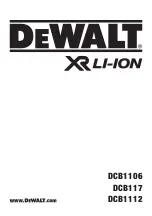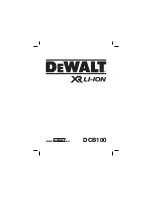
HOW IT WORKS — AMP-L-START™ works by "borrowing" some charging current from the house batteries, using it to also recharge and maintain the starting
battery(s). This only happens when the house batteries are receiving a charge from your DC power converter, AC inverter/charger or solar panels — The rest of the
time, AMP-L-START™ is inactive, and doesn't affect the electrical system. After both the starting and house batteries become fully charged, AMP-L-START™
continuously applies a small maintenance charge to the starting battery(s). During periods when the house batteries are being discharged (i.e., when dry-camping),
AMP-L-START automatically stops any reverse current flow, thereby preventing the starting battery(s) from also being discharged.
OPERATING INFORMATION — The yellow CHARGING light will illuminate whenever the starting battery is accepting a substantial charge (i.e., more than several
amps). After the starting battery approaches a full state of charge, the green MAINTAINING light will illuminate instead, indicating that the battery is accepting only a
small maintenance charge. Shortly after shore power is disconnected or solar panel output ceases, the MAINTAINING light will briefly flash every few seconds, indicating
that AMP-L-START™ is in standby mode. While in this mode, the current drain on the house and starting batteries is less than 0.002 amps (2 mA).
"HIGH TEMPERATURE" MODE — Installing a jumper across the 2 pins on the back of the unit (marked with a "*") reduces the turn-on voltage from 13.2 to 12.7 volts,
and reduces the turn-off voltage from 12.8 to 12.5 volts. This allows the starting batteries to still receive a maintenance charge if the house battery charger has reduced
its float voltage in very hot weather. To confirm operation in this mode, the unit beeps 8 times (rather than 4 times) when first powered up; thereafter, the House Bat.
and Starting Bat. lights blink in rapid sequence every few seconds. Without the jumper installed (or only installed on 1 of the 2 pins), the unit operates in its "NORMAL"
mode (13.2 volts turn-on, 12.8 volts turn-off). The unit is shipped from the factory in "NORMAL" mode (jumper only installed on 1 pin.) NOTE: "High Temperature" mode
is only intended for use in motorhomes equipped with a temperature-compensated house battery charger or inverter/charger, and only then in very hot weather. Since
most house battery chargers are not temperature-compensated, most users will never need to activate it.
L S L PRODUCTS • 5804 BABCOCK RD. # 512 • SAN ANTONIO, TX 78240 • TOLL-FREE: 877-257-4655 • www.LSLproducts.net
General Information
In Case Of Trouble
MAINTAINING light blinks every second — Indicates that the unit is operating normally, but the house battery voltage isn't high enough to charge or maintain the
starting battery(s) (i.e., isn't above approx. 13.2 volts, measured at the HOUSE [+] terminal). If this occurs when the unit should be operating, check for (1.) disconnected
shore power, (2.) house battery charger unplugged or switched off, (3.) heavily-discharged house batteries.
HOUSE BAT. or STARTING BAT. lights are flashing — Indicates that either the house or starting batteries are not connected to the unit (i.e., measured battery voltage
is less than 2 volts). Check for loose connections, open disconnect switches or improper wiring.
MAINTAINING and CHARGING lights are flashing simultaneously — Indicates that the unit has shut down, due to excessively high house battery voltage (above
approx. 14.75 volts). This is done to protect the starting batteries, and can occur when the house battery charger is either (1.) recharging or equalizing the house
batteries, (2.) malfunctioning or misadjusted. Normal operation will resume when the house battery voltage drops back below approx. 14.5 volts.
Unit is beeping, and STARTING BAT. light glows steady – Indicates that the starting battery(s) is severely discharged to the point where permanent damage is
possible (approx. 11.9 volts). Check your house battery charger to confirm that it is powered up, and is operating normally. To silence the beeper, temporarily disconnect
Starting [+] terminal or your starting battery (by using your battery disconnect switch) until the battery can be recharged.
MAINTAINING or CHARGING lights are illuminated after shore power is disconnected – Indicates that the house battery voltage has not yet dropped enough to
turn the unit off (i.e., below approx. 12.8 volts). This situation will remedy itself as the battery surface charge gradually bleeds off, but can take up to several hours.
Red REVERSE POL. light is illuminated — Indicates a wiring error (i.e., the GND. [–] terminal is connected to the positive side of the house or starting batteries).
Warranty
LSL Products warranties this unit for a period of ONE YEAR from the date of purchase against defects in materials and workmanship. Please save your receipt as proof
of warranty coverage. LSL Products will, at its option, repair or replace any defective components, at no charge to the owner. Please contact us prior to returning the unit.
This warranty does not cover damage due to improper installation or unreasonable use of the product. In no event shall LSL Products nor any of its representatives be
responsible for incidental or consequential damages. This warranty gives you specific legal rights, and you may have other rights which vary from state to state.
If a solid-state isolator is present, it will look very
similar to this:
If a relay (or solenoid)-type isolator is present, it will
look very similar to one of these two relays:
Connecting your AMP-L-START™ to the terminals on your battery isolator or emergency start relay has several advantages over connecting it directly to the posts on
your batteries: (1.) It eliminates the need to run long wires to each battery bank (since the manufacturer has already routed wires from both battery banks to these
devices). (2.) It avoids exposing the connections to corrosive battery fumes and electrolyte.
WHERE TO LOOK FOR THE ISOLATOR — The isolator is often located either inside or immediately next to the engine compartment:
Note: An isolator relay will click whenever the engine ignition switch is turned from the
"off" to "run" positions. An emergency start relay will click whenever the "Emergency
Start" switch on the dashboard is pressed. Listen for these sounds to find the relay.
At the factory, the manufacturer has connected one of these large terminals to the
positive terminal of your house battery bank. The other large terminal is connected to
the positive terminal on your starting battery(s). You want to connect AMP-L-
START's HOUSE [+] stud to the terminal that goes to the HOUSE batteries, and
connect AMP-L-START's STARTING [+] stud to the terminal that goes to the
STARTING battery(s).
At the factory, the manufacturer has connected one of these terminals to the positive
terminal of your house battery bank. Another terminal is connected to the positive
terminal on your starting battery(s), and the last terminal is connected to the DC output
from your engine's alternator.You want to connect AMP-L-START's HOUSE [+] stud to
the terminal that goes to the HOUSE batteries, and connect AMP-L-START's
STARTING [+] stud to the terminal that goes to the STARTING battery(s). (NOTE:
Some isolators show the connections on an attached sticker or label.)
HOW TO TELL WHICH WIRE GOES TO WHICH BATTERY — When plugged into AC power (so that your DC converter or AC inverter is charging the house batteries),
the wire that goes to your house batteries will measure around 13.5 to 14.5 volts (measuring between the terminal and ground). The wire that goes to your starting
batteries will measure less than this (around 12.3 to 12.7 volts). If you don't have access to a DC voltmeter, you can use a 12-volt light bulb or test light instead —
Temporarily disconnect the positive terminal of your starting battery and see which terminal on the isolator still lights the bulb. That will be the wire that goes to the house
batteries. Reconnect the starting battery, and perform the same test on the house batteries (which will tell you which wire goes to the starting battery).
“Where's The Isolator?”
...Or...




















